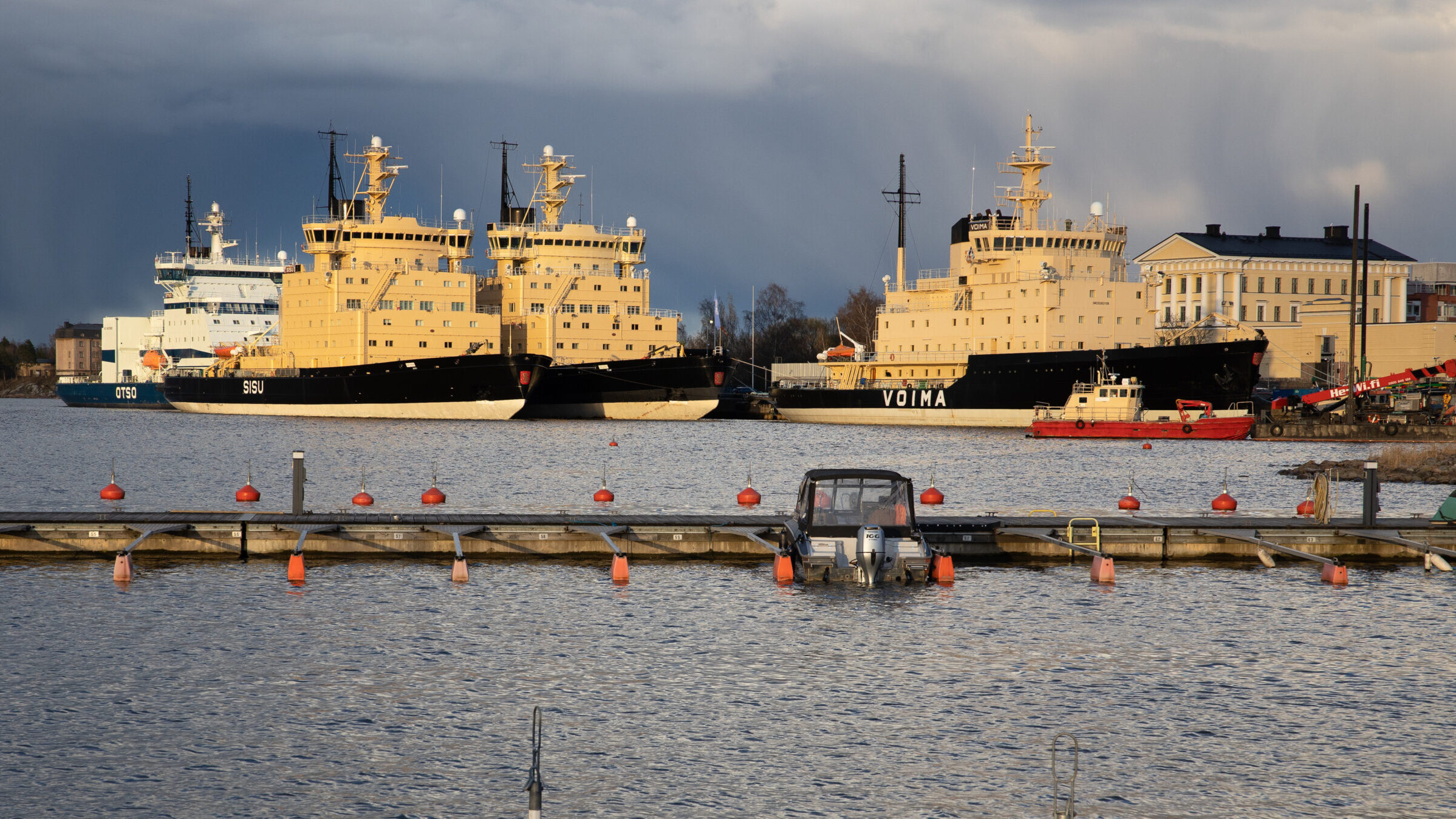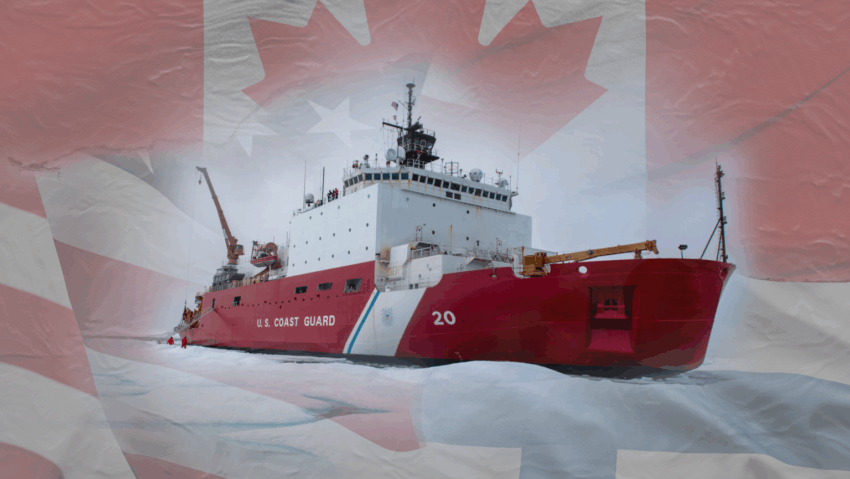The icebreaker USCGC Healy (WAGB 20) keeps station while conducting crane operations alongside a multi-year ice floe for a science evolution in the Beaufort Sea, Aug. 9, 2023. (U.S. Coast Guard photo by Petty Officer 3rd Class Briana Carter, flags via Getty)
WASHINGTON — A year ago today, then-President Joe Biden stood with Canadian Prime Minister Justin Trudeau and Finnish President Alexander Stubb to unveil the Icebreaker Collaboration Effort Pact, also dubbed ICE Pact.
As the leaders laid out, ICE Pact would be a trilateral security agreement that bolstered all three countries’ ability to design and build icebreakers, a unique type of ship made for Arctic conditions — ships necessary to challenge Russia and China as polar ice melts and sea lanes increasingly reveal themselves.
“Said differently, without this arrangement, we’d risk our adversaries developing an advantage in a specialized technology with vast geostrategic importance,” a White House official said at the time.
The agreement has now been inherited by the Trump administration, which has been equally enthusiastic about the need to bolster and maintain a persistent American presence in the High North.
But experts and analysts told Breaking Defense that one year since the ICE Pact’s announcement, and despite Trump’s clear support for a robust icebreaker fleet, the administration’s own talk of the specifics of the plan, not to mention the president’s open threats against one of its two partners, has called the future of the joint initiative into question, at least in its current form.
RELATED: ICE Pact: Why the US had to recruit help in race with Russia, China for Arctic icebreakers
“President Trump’s messaging on ICE Pact has been mixed — he has both questioned Canada’s involvement and simultaneously praised Finland’s know-how on icebreaker construction,” Jason Moyer, a non-resident fellow at the Atlantic Council, told Breaking Defense. “At the highest levels of the US government, the moniker of ICE Pact seems to no longer be used — but that largely falls in line with this administration’s preference for bilateral relations, the strained relationship with Canada over tariffs, and the strong relationship between Finnish President Alexander Stubb and President Trump.”
Chilly Waters, Muddy Message
The confusion around ICE Pact’s future stems from two issues, experts told Breaking Defense. The first factor was the vague path set out by the previous administration concerning the agreement’s end goals. The second issue is the current White House’s muddled messaging on its apparent desire to acquire icebreakers directly from Finland juxtapose with aggressively posturing towards Canada.
When Biden and his counterparts presented the agreement last year, they talked broadly of the need for icebreakers to ensure all three countries can maintain their economic and national security in the High North moving forward.
But Biden also talked about revitalizing the domestic shipbuilding industry by bringing home Canadian and Finnish expertise for the benefit of American shipyards. The Trump administration reiterated those messages in June following a two-day summit among ICE Pact’s participants.
“ICE Pact is a key component of America’s economic future. President Donald Trump and U.S. Homeland Security Secretary Kristi Noem understand that economic security is national security,” Tricia McLaughlin, the top spokesperson at DHS, said in a statement at the time. “By revitalizing U.S. shipyards, creating jobs, strengthening industrial capabilities, and opening up the Arctic’s vast potential to American businesses, the Trump administration is putting America’s prosperity and security first.”
But what Biden’s administration never made clear publicly were specific plans to either build or buy icebreakers domestically, beyond the Coast Guard’s preexisting plans, or from foreign nations. Contrast that to the AUKUS agreement, also a trilateral security pact, which featured the heads of state convening in California in 2023 to provide a detailed roadmap of how and when Australia would operate nuclear-powered submarines.
Peter Rybski, a retired US Navy officer and former naval attaché to the US Embassy in Helsinki, said he was skeptical of the previous administration’s claims that ICE Pact would lead to a revitalization of American shipbuilding.
“If you read the ICE Pact, it basically says that it’s about technological cooperation and information exchange and all these sorts of things that can be government to government,” he told Breaking Defense. That arrangement may work for AUKUS because information about nuclear propulsion technology is held by the government. “But icebreakers are built by commercial shipyards,” he said.
“How is this [ICE Pact] really suppose to help?” he asked.
Rybski said ICE Pact provided “a good opportunity for folks to meet and talk,” noting the dialogue taking place between the US Coast Guard and some foreign shipbuilders. “But as far as the vision the [White House National Security Council] put forward last year about bringing ice breaking technology home to the US, and revitalizing the shipbuilding industry by building icebreakers for the world and the United States, that never seemed to me to be a plausible or realistic argument. And I think that’s bearing itself out pretty clearly.”
Trump has praised ICE Pact partner Finland, referring to the country as the “king of icebreakers” during last month’s NATO summit, the latest of many overtures about the US buying ships directly from Helsinki.
Canada, on the other hand, has long been the target of harsh condemnation from Trump. The president has repeatedly threatened Canada with numerous tariffs on a variety of goods to include a 50 percent tariff on steel and aluminum imports, which in turn provoked retaliatory measures from the Canadian government. The economic tensions — combined with Trump’s ominous threats to annex the country — raise questions about what part it could still play in ICE Pact.
“It seems as though the stronger arm of the trilateral partnership is between the United States and Finland, with Canada’s role being downplayed, at least publicly,” Moyer, the fellow at the Atlantic Council, said. “This also fits with President Trump’s preference for bilateral talks over multilateral formats.”
Spokespeople for the White House did not respond to Breaking Defense’s questions for this report. A DHS spokesperson deferred questions about ICE Pact to a press release issued shortly after the June summit.

Several of Finland’s icebreaker vessels moored in the South Harbour at the port of Helsinki in Helsinki, Finland, May 3, 2023. Finland is among the most active builders of icebreakers. (Andrey Rudakov/Bloomberg via Getty Images)
Where’s The Money Going?
Matthew Paxton, president of the Shipbuilders Council of America, told Breaking Defense that industry is “excited” about the investment into shipbuilding the administration has foreshadowed, but said the possible deal with Finland is “confusing.”
“What’s the signal here?” he said. ICE Pact is about “building icebreakers in the three nations’ shipyards for their purposes. … The vision of ICE Pact was not to say, ‘We’re going to send US tax dollars to build icebreakers in Finland.’”
“We’ve gotten all the signals of, ‘We’re going to do things here,’ and then that statement was made,” he said, referring to Trump’s comments at the NATO summit. “So, I think ‘confusion’ is probably a good way to put it.”
Icebreakers are historically not a strong suit for most American shipyards, but thanks to Congress, the money to act is on the table. Included in lawmakers’ “One Big, Beautiful Bill,” passed earlier this month, is $8.6 billion earmarked for US Coast Guard icebreaker procurement: $4.3 billion for the service’s Polar Security Cutter program; $3.5 billion for Arctic Security Cutters and $816 million for medium- and light-class vessels.
As Breaking Defense previously reported, different countries use different metrics and phrases to classify them. For example, Rybski, the retired US Navy officer who also follows and writes about Finnish shipbuilding, said the US Coast Guard’s tendency to use phrases like “polar” and “Arctic” icebreakers is largely unique to the American service. In this parlance, polar refers to the largest class of icebreakers most capable of plying polar waters, whereas Arctic cutters are smaller vessels with less stringent requirements for what thickness of ice they must break.
The White House last year named Bollinger Shipyards, of Louisiana, as being integral to ICE Pact during its initial announcement. That yard is the prime contractor for the Coast Guard’s premiere icebreaker construction program, the Polar Security Cutter.
Meanwhile, the Canadian government has entrusted two domestic shipbuilders, Seaspan Shipyards and Davie Shipbuilding, with the building its newest icebreakers.
Since the inception of ICE Pact, Davie has made several moves to strengthen its shipbuilding position among the three countries. The company in June announced it would acquire Gulf Copper’s Texas shipyards, noting that “an American shipyard would make Davie uniquely positioned in the trilateral Icebreaker Collaboration Effort to deliver advanced icebreakers at speed, scale, and competitive cost.” That “uniqueness” stems from the company now being poised to own yards in Canada, the United States and Finland, where it owns Helsinki Shipyard, considered a leader in icebreaker production even among its Finnish peers.
Davie “is a major player in the shipbuilding space, so even if the US and Finland move forward with icebreakers, Canada or Canadian companies will have a presence in these conversations,” said Moyer.
As for the future of the ICE Pact itself, Moyer predicted the end goal of acquiring new icebreakers would proceed in some form or fashion, even if it’s not the one envisioned by the previous administration.
“US-Finnish cooperation has never been better, with Canada likely on the outs due to the current state of the bilateral relationship, although they still remain a partner in ICE Pact,” he said. “But the main goal of the ICE Pact, to build more icebreakers, seems to still be continuing, albeit more so on a bilateral basis.”
Click this link for the original source of this article.
Author: Justin Katz
This content is courtesy of, and owned and copyrighted by, https://breakingdefense.com and its author. This content is made available by use of the public RSS feed offered by the host site and is used for educational purposes only. If you are the author or represent the host site and would like this content removed now and in the future, please contact USSANews.com using the email address in the Contact page found in the website menu.








